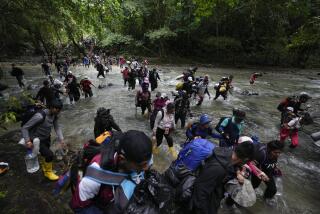Market Scene : Trail Coming to an End for Spanish Shepherds : Migratory routes give way to highways and railroads. But legislation aims to preserve a piece of the past.
- Share via
POBLADURA DE ALISTE, Spain — In this isolated hamlet where stooped women still plow rocky plots with yoked oxen, the day that the shepherds return triumphant each year from distant summer pastures may soon pass into village history.
Smelling as earthy as their language, seven weary shepherds have just spent two months in the mountains, herding about 6,000 sheep and a score of goats along a winding, nationwide network of trails that a Spanish king granted their forebears some seven centuries ago.
These aging shepherds--like a dwindling number of others throughout Spain--have made few concessions to the modern world over the years, and the modern world has treated them in kind.
Now, the trails they regularly follow have been crisscrossed by busy highways, blocked by illegal construction and despoiled by illicit dumping. Slowly but surely, many such trails are fading from the Spanish landscape.
And as the old shepherds die, the trails they have walked are fading from memory too.
“It’s ending,” said head shepherd Antolin Pascual Calvo, at 49 among the group’s youngest. “It’s too bad.”
Spain’s Agriculture Ministry, concerned that an important element of Spanish culture may soon vanish forever, is working on new legislation to protect the estimated 78,000 miles of trails from further encroachment. Its passage may come next year.
“We’ve reached a critical point. Either we protect them now, or we won’t have the migratory routes,” said Jose M. Mangas Navas, who is coordinating the project under the auspices of the National Institute for the Conservation of Nature.
Recognizing that fewer than 2% of Spain’s estimated 23 million sheep ever use these routes-- vias pecuarias --one plan calls for turning some routes into a network of hiking trails.
Shepherding has a history in Spain stretching back thousands of years. According to historian John A. Crow, the great seasonal migrations of ancient days were interrupted by the Moorish invasion in AD 711, then resumed in the 13th Century as Christian forces reconquered vast tracts of land in their march south.
During this period, a powerful shepherds union secured extensive rights of way from King Alfonso X (1252-1284), and the annual migration, or trashumancia , became the stuff of Spanish song and legend.
Today, many of these rights of way still stand, but the great migrations have given way to railroads, industrial farming techniques and a predominantly urban society. Mangas said only about 300 sheep herders make the long journeys along the trails today; exact numbers are not known. Still, an estimated 400,000 sheep and a relative handful of cattle and goats are driven along the old trails every year.
Manolo Santos, 26, a local shepherd’s son who works as a waiter in Madrid, said the shepherd’s life is just too hard. Like other young men, he has moved to a modern city in pursuit of shorter hours, better pay and a more comfortable lifestyle.
Home to help separate his father’s animals from their woolly look-alikes, he gets nostalgic about the shepherding tradition--but only to a point.
“You can come here for a month of vacation, but you can’t live this way. It’s slavery,” he said.
The lack of young shepherds to replace those retiring is perhaps a greater threat to this way of life than the depressed price of lamb on the world market.
“If things keep going the way they are, in 10 years there won’t be a trashumancia ,” said Javier Teres Landata, an environmental biologist who is helping document the situation for the Agriculture Ministry.
With relatively few written records to go on, the ministry has sent aerial photographers aloft and researchers out in four-wheel-drive vehicles, tracking down old shepherds and transcribing their meandering memories onto modern maps.
“It’s a slow and difficult process,” said Mangas, whose researchers must first gain the trust of shepherds who perceive them as nosy city slickers.
Shepherd Atilano Silva Calvo, 66, who carries a curved crook oiled smooth from the wool of countless sheep, said he has trekked to and from the distant mountains for half a century but that none of his four children are following in his footsteps.
“You do it because you have to,” he said, brushing aside some buzzing flies. “In good weather, it’s OK. In bad weather, it’s bad.”
For Silva and his fellow shepherds, ominous clouds loom. A few bureaucrats and politicians are doing what they can to save the pathways, but they can’t halt the march of time.
More to Read
Sign up for Essential California
The most important California stories and recommendations in your inbox every morning.
You may occasionally receive promotional content from the Los Angeles Times.













